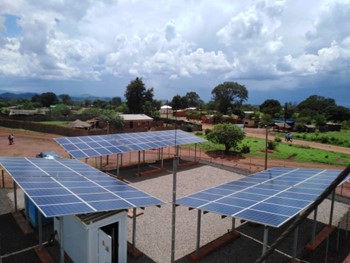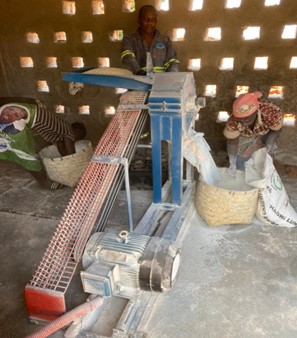Mini-grid Solutions in Chitandika, Zambia
Energy poverty, lack of access to clean and affordable energy is a pressing global issue. Mini- grids have emerged as a promising solution to addressing energy access challenges in the remote and underserved communities around the world. Situated in the East of Zambia, Chitandika, a small rural village located about 600 km from the capital city, Lusaka, is home to an initiative that’s bringing not just light but productive electrification to the lives of its residents. Chitandika, with approximately 450 households, thrives on agriculture activities. In addition to households, Chitandika boasts rural workshops equipped with welding, grinding, and drilling machines, as well as 2 maize hammer mills, each equipped with a de-huller. The village also features salons with 6 hair-blowing machines, 10 barber shops, and 9 shops with refrigeration facilities.

Chitandika solar mini-grid, Eastern Province, Zambia. Photo: M. Munkowbwe, 2023.
MySolGrid, formerly known as Engie Power Corner, installed their flagship solar mini-grid in Chitandika which has become a beacon of hope in this vibrant rural agricultural community. Chitandika’s mini-grid is a shining example of sustainable energy innovation. Equipped with a solar array of 28.3-kilowatt peak capacity, a 90-kilowatt-hour battery bank, and a 40kVA Stand-by diesel generator. This power system officially lit up the village in April 2019. Its creation was made possible through collaboration with various sector players. The solar mini-grid has brought much-needed electrification to both domestic and commercial entities in the area. As of January 2023, the client portfolio served by the mini-grid comprised 207 households, 33 of which had electric pressure cookers.

An electric hammermill more efficiently converts maize into mealie meal. . Photo: M. Munkowbwe, 2023.
The current tariff structure is designed to cater to the diverse needs of Chitandika’s residents. It ranges from approximately $USD 0.50 to about $USD 1.00 per kilowatt-hour of electricity, with domestic tariffs being slightly higher than commercial tariffs. To ensure efficient consumption, MySol Grid has incorporated intelligent smart metering. This technology allows for time-of-use pricing and load limiting thus promoting responsible energy use and efficient system control with limited human intervention. Furthermore, it enables remote monitoring of the power system and the metering infrastructure, ensuring reliability and transparency in billing.
In Zambia, the Chitandika mini-grid stands as a pioneer, incorporating productive uses as part of its business model. This unique approach has helped uplift the community and serves as a blueprint for other off-grid implementers to replicate. The lessons learned from this successful project have also encouraged MySol Grid to expand its operations in Zambia. Funding from the Increased Access to Electricity and Renewable Energy Production program, an initiative under the 11th European Development Fund call, and debt financing from Cygnum Capital, amounting to 6 million Euros and $USD 7.5 million, respectively, have fueled their ambitions.
MySolGrid is now on track to develop an additional 60 mini-grids in Zambia, based on this funding. These mini-grids are expected to be commissioned in 2024, furthering the cause of sustainable energy and electrification in rural communities across the country. The impact of Chitandika’s solar mini-grid is not just a local success story but a shining example of how sustainable energy solutions can transform lives and rural communities across the world from darkness to stimulate socio-economic activities.
Author: Muntanga Munkowbwe
